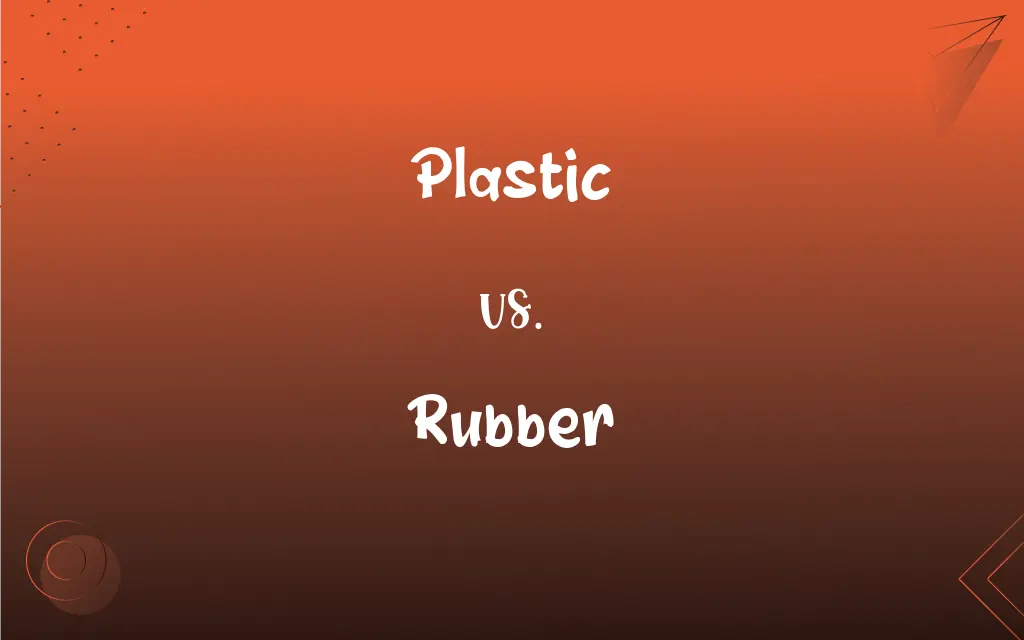Plastic vs. Rubber: What's the Difference?
Edited by Janet White || By Harlon Moss || Updated on October 4, 2023
Plastic is a synthetic or semi-synthetic material moldable at certain temperatures, while rubber is an elastic material obtained from latex or synthesized from petroleum.

Key Differences
Plastic, derived either from natural cellulose or petroleum-based compounds, is known for its moldability, versatility, and lightweight. Rubber, on the other hand, is primarily harvested from the latex of rubber trees or can be synthesized, prized for its elasticity and stretchability.
Plastic products vary from household items to complex industrial components, owing to their adaptability in hardness, density, and resilience. Rubber, while also versatile, is often found in products requiring elasticity, such as tires, bands, and seals, rebounding to its original form after being stretched or compressed.
Plastic materials can be thermosetting or thermoplastic, meaning they can either retain their shape after heating or be re-molded multiple times. Rubber, conversely, comes in natural or synthetic forms, with synthetic versions like neoprene or silicone offering specialized properties.
The environmental impact of plastic, especially single-use plastics, has been a significant concern due to its non-biodegradable nature. Rubber, particularly natural rubber, is biodegradable, though synthetic varieties might pose environmental challenges as well.
Many industries utilize both plastic and rubber, but their applications differ. Plastic might be preferred for rigidity, insulation, or translucence, while rubber is chosen for flexibility, grip, and elasticity.
ADVERTISEMENT
Comparison Chart
Origin
Synthetic or semi-synthetic
Natural (latex) or synthetic
Primary Characteristics
Moldable, versatile
Elastic, stretchable
Forms
Thermosetting, thermoplastic
Natural, synthetic (like neoprene or silicone)
Environmental Impact
Often non-biodegradable
Natural is biodegradable, synthetic varies
Typical Uses
Containers, electronics, furniture
Tires, bands, seals
ADVERTISEMENT
Plastic and Rubber Definitions
Plastic
Capable of being shaped or molded.
The artist found clay to be a plastic medium.
Rubber
Protective gloves made of rubber material.
He wore rubber gloves while cleaning.
Plastic
A synthetic or semi-synthetic moldable material.
The toy was made of colorful plastic.
Rubber
A synthetic material with similar properties to natural rubber.
The pipes were insulated with synthetic rubber.
Plastic
Relating to credit cards or plastic money.
I paid for the meal using my plastic.
Rubber
A series or set of games, typically three, in some card games.
They played a rubber of bridge.
Plastic
Lacking authenticity or genuineness.
His smile seemed plastic and insincere.
Rubber
An elastic substance obtained from the latex sap of trees.
He wore shoes with rubber soles.
Plastic
Concerning or specialized in plastic surgery.
She visited a renowned plastic surgeon.
Rubber
An eraser made of rubber or similar material.
She used a rubber to erase the pencil marks.
Plastic
Capable of being shaped or formed
Plastic material such as clay.
Rubber
Any of numerous synthetic elastic materials of varying chemical composition with properties similar to those of natural rubber; an elastomer.
Plastic
Relating to or dealing with shaping or modeling
The plastic art of sculpture.
Rubber
A yellowish, amorphous, elastic material, composed almost entirely of an isoprene polymer, obtained from the milky sap or latex of various tropical plants, especially the rubber tree, and vulcanized, pigmented, finished, and modified into products such as electric insulation, elastic bands and belts, tires, and containers. Also called caoutchouc, India rubber.
Plastic
Having the qualities of sculpture; well-formed
"the astonishing plastic beauty of the chorus girls" (Frank Harris).
Rubber
A low overshoe made of rubber.
FAQs
Can plastics be recycled?
Many plastics can be recycled, though the degree and method vary.
Are plastic and rubber ever combined in products?
Yes, many products, like car tires, might combine both materials for specific benefits.
Are all plastics rigid?
No, plastics vary in rigidity. Some can be very flexible, like plastic bags.
What is plastic made from?
Plastic is made from natural cellulose or petroleum-based compounds.
Are all plastics non-biodegradable?
Most common plastics are non-biodegradable, but there are biodegradable plastics available.
Is natural rubber eco-friendly?
Natural rubber is biodegradable, making it more eco-friendly than many synthetic alternatives.
What's the difference between thermoplastic and thermosetting plastic?
Thermoplastics can be re-melted and re-molded, while thermosetting plastics retain their shape after setting.
What are rubber gloves typically used for?
Rubber gloves are used for protection, often during cleaning or handling chemicals.
Is rubber naturally occurring?
Yes, natural rubber is derived from the latex sap of rubber trees.
Can rubber be colored?
Yes, rubber can be colored using various dyes and chemicals.
Which is more heat resistant, plastic or rubber?
It varies by type, but generally, some plastics can resist higher temperatures than natural rubber.
How is synthetic rubber produced?
Synthetic rubber is produced from petroleum-derived compounds through polymerization processes.
Why is rubber elastic?
Rubber's elasticity is due to its molecular structure that allows it to stretch and return to its original shape.
Can synthetic rubber have specialized properties?
Yes, synthetic rubbers like neoprene or silicone offer specialized properties.
What is a common use for plastic in households?
Plastic is commonly used for containers, bottles, and toys.
Why are tires commonly made of rubber?
Rubber provides flexibility, grip, and durability, essential for tire functionality.
Are there biodegradable plastics?
Yes, some specially designed plastics are biodegradable.
How does temperature affect plastics?
Plastics can become moldable or even melt at certain temperatures.
How are plastics colored?
Plastics are colored using dyes or pigments during the production process.
Is latex the only source of natural rubber?
While latex from rubber trees is the primary source, some other plants also produce rubber-yielding latex.
About Author
Written by
Harlon MossHarlon is a seasoned quality moderator and accomplished content writer for Difference Wiki. An alumnus of the prestigious University of California, he earned his degree in Computer Science. Leveraging his academic background, Harlon brings a meticulous and informed perspective to his work, ensuring content accuracy and excellence.
Edited by
Janet WhiteJanet White has been an esteemed writer and blogger for Difference Wiki. Holding a Master's degree in Science and Medical Journalism from the prestigious Boston University, she has consistently demonstrated her expertise and passion for her field. When she's not immersed in her work, Janet relishes her time exercising, delving into a good book, and cherishing moments with friends and family.































































